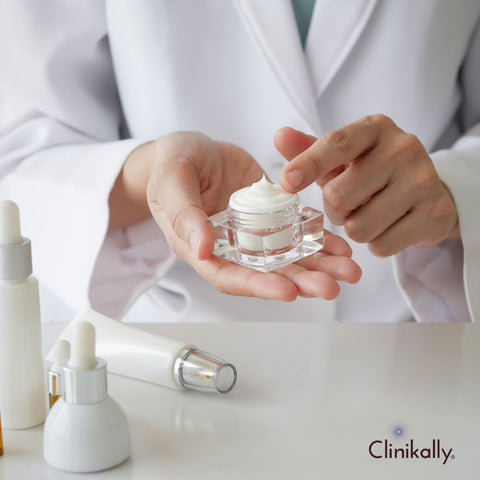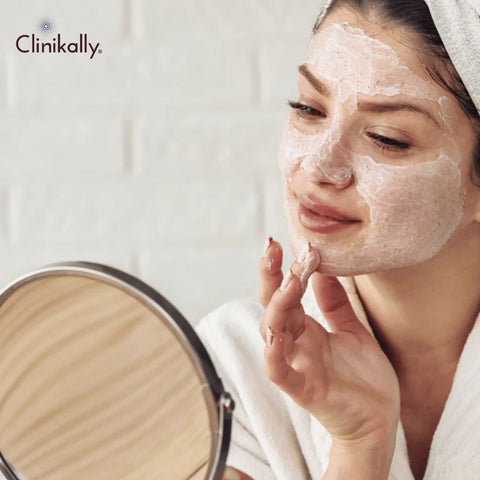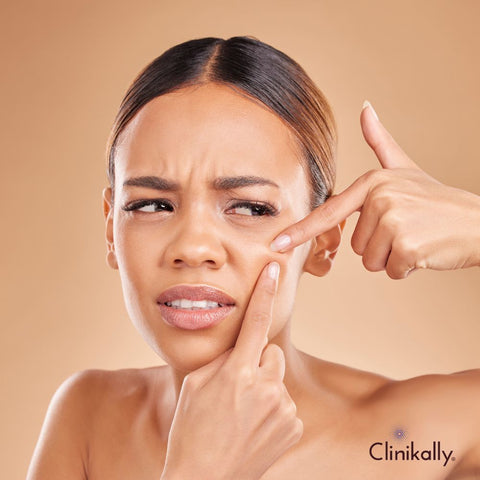Dry skin breakouts can be a frustrating challenge, often seeming like a never-ending battle. But fear not, as armed with the right knowledge and tools, you can conquer these pesky blemishes and achieve clearer, healthier skin. Understanding the intricate relationship between dryness and breakouts is the first step towards effective management. Dry skin lacks sufficient moisture, leading to compromised skin barrier function. When this barrier is weakened, it becomes more susceptible to external irritants and bacteria, which can trigger inflammation and acne breakouts. Establishing a daily skincare routine and sticking to it religiously can yield significant improvements over time. Remember to be patient and persistent, as achieving clear, healthy skin is a journey that requires dedication and commitment. By implementing these strategies and prioritizing skin health, you can effectively conquer dry skin breakouts and unveil a radiant complexion you can be proud of.
Understanding the Dynamics: Dry Skin, Hormones, and Breakouts

Dry skin, hormones, and breakouts are interconnected factors that often contribute to skin woes. Hormonal fluctuations, particularly in women, play a significant role in acne development, regardless of age. These fluctuations can trigger an increase in sebum production, leading to clogged pores and subsequent breakouts. Moreover, hormonal imbalances can disrupt the skin's natural moisture balance, exacerbating dryness and compromising the skin barrier.
Dry skin, characterized by a lack of moisture and compromised barrier function, creates an environment conducive to acne formation. When the skin lacks proper hydration, it becomes more susceptible to external irritants and bacteria, further exacerbating inflammation and breakouts. Additionally, dry skin may overcompensate by producing excess oil, leading to a cycle of increased sebum production and acne flare-ups.
Understanding the dynamics between dry skin, hormones, and breakouts is crucial for effective management. Implementing a targeted skincare routine that addresses both dryness and acne is essential. This may involve incorporating gentle cleansers, hydrating moisturizers, and spot treatments formulated to unclog pores and reduce inflammation.
Furthermore, maintaining hormonal balance through lifestyle modifications and, if necessary, consulting with a healthcare professional can help mitigate acne flare-ups associated with hormonal fluctuations. Incorporating stress-reduction techniques, adequate sleep, and a balanced diet rich in antioxidants and essential nutrients can also support overall skin health and minimize hormonal acne.
By recognizing the interconnectedness of dry skin, hormones, and breakouts, individuals can tailor their skincare approach to effectively manage these concerns. By addressing underlying imbalances and nourishing the skin with appropriate products and practices, it is possible to achieve clearer, healthier skin and regain confidence in one's complexion.
Unravelling the Complex Relationship Between Hormonal Changes and Breakouts

Understanding the intricate link between hormonal changes and breakouts is crucial for effectively managing skin concerns. Hormonal fluctuations, particularly in women, can significantly impact the skin's health and appearance. These fluctuations, which occur during various life stages such as puberty, pregnancy, perimenopause, and menopause, can lead to an array of skin issues, including dryness and breakouts.
Hormonal fluctuations, particularly those involving estrogen, play a pivotal role in skin health. Estrogen levels influence the production of essential components like elastin, collagen, and hyaluronic acid, which are vital for maintaining the skin's moisture retention and elasticity. As estrogen levels fluctuate, especially during perimenopause and menopause, the skin may experience increased dryness and trans-epidermal water loss, resulting in dehydration and a heightened susceptibility to breakouts.
Moreover, the menstrual cycle introduces further hormonal variations that can impact the skin. During certain phases of the menstrual cycle, particularly the follicular phase, estrogen and progesterone levels are lower, leading to drier and duller skin. This fluctuation in hormone levels underscores the importance of adjusting skincare routines to address specific needs at different stages of the menstrual cycle.
Phytoestrogens, natural compounds found in some plants and foods, have emerged as a promising solution for addressing hormone-impacted skin. These compounds mimic the effects of estrogen on the skin without systemic effects, providing a potential avenue for restoring hormonal balance.
The Wrong Skincare Moves: Avoiding Pitfalls in Managing Dry Skin Breakouts

Navigating the delicate balance of managing dry skin breakouts requires avoiding common skincare pitfalls that can exacerbate the issue. Here are key missteps to steer clear of:
Over-Cleansing: While cleansing is crucial, overdoing it can strip the skin of its natural oils, leading to increased dryness and irritation. Opt for a gentle, hydrating cleanser and limit washing to twice daily.
Skipping Moisturizer: Dry skin needs adequate hydration to maintain its barrier function. Skipping moisturizer can worsen dryness and trigger more breakouts. Choose a non-comedogenic, hydrating moisturizer to replenish lost moisture.
Harsh Exfoliation: Abrasive exfoliants can aggravate dry, sensitive skin and cause micro-tears, making breakouts worse. Instead, opt for gentle exfoliation with mild acids or enzymes to slough off dead skin cells without stripping the skin.
Overuse of Drying Treatments: While spot treatments can be effective for acne, using them excessively can dehydrate the skin and exacerbate dryness. Use targeted treatments sparingly and follow up with hydrating products.
Ignoring Sun Protection: UV rays can worsen dryness and inflammation, leading to more pronounced breakouts. Always apply a broad-spectrum sunscreen with SPF 30 or higher, especially when using acne treatments that increase sun sensitivity.
Using Irritating Ingredients: Certain ingredients, such as alcohol, fragrances, and harsh detergents, can further irritate dry skin and trigger breakouts. Opt for products with gentle, soothing ingredients like hyaluronic acid, aloe vera, and ceramides.
Crafting Your Skincare Arsenal: Tips for Effectively Managing Breakouts with Dry Skin

To effectively manage breakouts while nurturing dry skin, assembling the right skincare arsenal is key. Here are some expert tips to curate your routine:
Gentle Cleansing: Start with a non-stripping, hydrating cleanser to remove impurities without disrupting the skin's natural moisture barrier. Look for ingredients like hyaluronic acid and glycerin to hydrate as you cleanse.
Hydrating Serums: Incorporate hydrating serums containing ingredients like hyaluronic acid, ceramides, and niacinamide to replenish moisture and support skin barrier function. These serums help maintain hydration levels without clogging pores.
Targeted Treatments: Choose spot treatments formulated with ingredients like salicylic acid or benzoyl peroxide to address breakouts without causing excessive dryness. Apply these treatments only to affected areas to avoid over-drying surrounding skin.
Moisture-Rich Moisturizers: Opt for rich, emollient moisturizers that provide deep hydration and nourishment. Look for ingredients like shea butter, squalane, and jojoba oil to lock in moisture and soothe dry, irritated skin.
Sun Protection: Protect your skin from UV damage by applying a broad-spectrum sunscreen with SPF 30 or higher every morning. Choose a sunscreen that is lightweight and non-comedogenic to avoid clogging pores.
Weekly Exfoliation: Incorporate a gentle exfoliating treatment into your routine once or twice a week to slough off dead skin cells and prevent clogged pores. Look for chemical exfoliants with AHAs or BHAs to refine skin texture without causing irritation.
Hydration from Within: Stay hydrated by drinking plenty of water throughout the day to support overall skin health and hydration. A well-hydrated body promotes healthy skin function and can help minimize breakouts.
Consult a Dermatologist: If you're struggling to manage breakouts and dryness, consider seeking advice from a dermatologist. They can provide personalized recommendations and treatments tailored to your specific skin concerns.
Choosing Wisely: Skincare Products and Ingredients for Dry Skin and Acne

When dealing with dry skin and acne, selecting the right skincare products and ingredients is crucial for maintaining skin health and clarity. Here's how to choose wisely:
Non-Comedogenic Formulas: Look for products labeled as non-comedogenic, meaning they won't clog pores. These formulations are less likely to exacerbate acne while providing essential hydration for dry skin.
Hydrating Cleansers: Opt for gentle, hydrating cleansers that effectively remove dirt, oil, and impurities without stripping the skin's natural oils. Ingredients like hyaluronic acid, glycerin, and ceramides help maintain moisture balance.
Moisture-Rich Moisturizers: Choose moisturizers specifically formulated for dry, acne-prone skin. Look for ingredients such as hyaluronic acid, shea butter, and ceramides to hydrate and nourish without clogging pores.
Oil-Free and Lightweight Formulas: When selecting moisturizers, serums, and sunscreens, opt for oil-free and lightweight formulas that won't feel heavy or greasy on the skin. These products provide hydration without exacerbating acne.
Spot Treatments with Salicylic Acid: Incorporate spot treatments containing salicylic acid to target acne blemishes effectively. Salicylic acid exfoliates dead skin cells, unclogs pores, and reduces inflammation without over-drying the skin.
Gentle Exfoliants: Choose exfoliating treatments with gentle acids like AHAs (alpha hydroxy acids) or BHAs (beta hydroxy acids) to remove dead skin cells and prevent pore congestion. Avoid harsh physical exfoliants, which can irritate dry, acne-prone skin.
Anti-Inflammatory Ingredients: Look for skincare products containing anti-inflammatory ingredients such as niacinamide, green tea extract, and licorice root extract. These ingredients help soothe irritation and reduce redness associated with acne breakouts.
Sun Protection: Don't skip sunscreen, even if you have acne-prone skin. Choose a lightweight, non-comedogenic sunscreen with SPF 30 or higher to protect your skin from harmful UV rays without clogging pores or causing breakouts.
The Importance of a Balanced Routine: Nourishing Dry Skin Without Aggravating Breakouts

Maintaining a balanced skincare routine is essential for nourishing dry skin without exacerbating breakouts. Here's why it matters:
-
Hydration is Key: Dry skin lacks moisture, leading to increased vulnerability to breakouts. Hydrating the skin with lightweight, non-comedogenic moisturizers helps restore moisture balance without clogging pores or triggering acne.
-
Gentle Cleansing: Harsh cleansers can strip the skin of its natural oils, worsening dryness and potentially causing irritation that triggers breakouts. Opt for gentle, hydrating cleansers that effectively remove impurities without compromising the skin's barrier function.
-
Targeted Treatments: Incorporate targeted treatments into your routine to address both dryness and acne. Look for products containing ingredients like hyaluronic acid to hydrate dry skin and salicylic acid to unclog pores and reduce acne breakouts.
-
Balanced Exfoliation: Exfoliation is essential for removing dead skin cells and promoting cell turnover, but excessive exfoliation can exacerbate dryness and inflammation. Use gentle exfoliants 1-2 times per week to maintain smooth, radiant skin without overdoing it.
-
Consistent Sun Protection: Sun exposure can worsen dryness and inflammation while also contributing to acne scarring. Apply a broad-spectrum sunscreen with SPF 30 or higher daily to protect your skin from UV damage and prevent further skin issues.
-
Mindful Product Selection: Choose skincare products formulated specifically for dry, acne-prone skin. Look for labels that indicate non-comedogenic, oil-free, and suitable for sensitive skin to minimize the risk of pore congestion and breakouts.
-
Patience and Persistence: Achieving balance in your skincare routine takes time and patience. Be consistent with your routine and give your skin time to adjust to new products or treatments. If you experience persistent issues, consult a dermatologist for personalized advice and treatment options.
When it comes to protecting your skin from the sun's harmful rays, finding the right products that won't clog pores is essential. Here are some sun protection essentials for shielding your skin without exacerbating acne:
- Non-Comedogenic Formulas: Look for sunscreen products labeled as non-comedogenic, which means they are specifically designed not to clog pores. These formulations are less likely to contribute to acne breakouts, making them ideal for acne-prone skin.
-
Oil-Free Sunscreens: Opt for oil-free sunscreens that won't add excess oil to your skin, as excess oil can lead to clogged pores and acne. Oil-free formulas are lightweight and won't leave your skin feeling greasy or congested, making them suitable for daily use.
-
Mineral Sunscreens: Mineral sunscreens containing zinc oxide or titanium dioxide are excellent choices for acne-prone skin. These ingredients provide broad-spectrum protection against UVA and UVB rays while being gentle on sensitive skin and less likely to cause breakouts.
-
Gel-Based Formulations: Gel-based sunscreens are lightweight and absorb quickly into the skin without leaving a heavy or sticky residue. They provide effective sun protection without clogging pores, making them ideal for those with oily or acne-prone skin.
-
Matte Finish Sunscreens: Sunscreens with a matte finish help control excess shine and provide a smooth, non-greasy appearance. These formulations are suitable for those with combination or oily skin types and can help prevent breakouts associated with excess oil production.
-
SPF Moisturizers: Consider using a moisturizer with built-in SPF protection to streamline your skincare routine. Look for lightweight, non-comedogenic moisturizers with added sun protection to hydrate your skin while shielding it from the sun's harmful effects.
-
Reapply Regularly: Regardless of the sunscreen you choose, remember to reapply it every two hours, especially if you're outdoors or sweating heavily. Proper and consistent application is crucial for maintaining effective sun protection throughout the day.
Dos and Don'ts for Managing Dry Skin and Breakouts

Do:
-
Hydrate Inside and Out: Drink plenty of water to hydrate your skin from within. Additionally, use moisturizers with hydrating ingredients like hyaluronic acid to maintain skin moisture levels.
-
Use Gentle Cleansers: Opt for mild, non-comedogenic cleansers that won't strip your skin of its natural oils. Look for ingredients like glycerin or ceramides to help retain moisture.
-
Patch Test New Products: Before fully incorporating new skincare products into your routine, perform a patch test to check for any adverse reactions or irritations, especially if you have sensitive skin.
-
Exfoliate Regularly: Gentle exfoliation can help remove dead skin cells, allowing moisturizers and treatments to penetrate more effectively. Choose chemical exfoliants like AHAs or BHAs over physical scrubs to avoid irritating dry or sensitive skin.
-
Seek Professional Advice: If your dry skin and breakouts persist despite at-home efforts, consult a dermatologist for personalized recommendations and treatment options tailored to your specific needs.
Don't:
-
Over-Exfoliate: Avoid over-exfoliating your skin, as this can strip away natural oils and exacerbate dryness and irritation. Stick to exfoliating 1-2 times per week to prevent skin damage.
-
Use Harsh Products: Steer clear of harsh skincare products containing alcohol, fragrances, or other irritants that can further dry out or irritate your skin. Opt for gentle, fragrance-free formulations instead.
-
Skip Sun Protection: Neglecting sun protection can worsen both dryness and breakouts. Always apply a broad-spectrum sunscreen with an SPF of 30 or higher, even on cloudy days, to shield your skin from harmful UV rays.
-
Pick or Pop Breakouts: Refrain from picking, squeezing, or popping pimples, as this can lead to scarring, inflammation, and further breakouts. Instead, treat blemishes with targeted spot treatments containing ingredients like benzoyl peroxide or salicylic acid.
-
Overlook Lifestyle Factors: Pay attention to lifestyle factors that may contribute to dry skin and breakouts, such as stress, diet, and sleep habits. Incorporate stress-relief techniques, eat a balanced diet rich in fruits and vegetables, and prioritize adequate sleep for overall skin health.
Finding the Balance: Using Spot Treatments Without Overdrying Your Skin

Finding the balance between effectively treating blemishes and avoiding over-drying or irritating your skin can be tricky, but it's achievable with the right approach. Here are some tips for using spot treatments without causing undue dryness or irritation:
-
Choose the right spot treatment: Look for spot treatments that contain ingredients known for their acne-fighting properties, such as benzoyl peroxide, salicylic acid, or tea tree oil. These ingredients can help target blemishes without overly drying out the surrounding skin.
-
Use a targeted approach: Apply spot treatments only to the areas where you have active breakouts or blemishes, rather than applying them to your entire face. This helps minimize the risk of over-drying unaffected areas of your skin.
-
Start with a lower concentration: If you're using a new spot treatment or have sensitive skin, start with a lower concentration of active ingredients and gradually increase as tolerated. This allows your skin to adjust to the treatment and reduces the risk of irritation.
-
Limit frequency of use: Avoid using spot treatments more frequently than recommended, as this can lead to over-drying and irritation. Follow the instructions provided with the product and give your skin time to recover between applications.
-
Moisturize properly: After applying a spot treatment, follow up with a gentle, non-comedogenic moisturizer to help maintain your skin's moisture barrier and prevent excessive dryness. Look for moisturizers that contain hydrating ingredients such as hyaluronic acid or ceramides.
-
Avoid harsh or abrasive products: In addition to spot treatments, be mindful of the other products you're using in your skincare routine. Avoid harsh or abrasive cleansers, exfoliants, and toners that can further strip your skin of moisture and exacerbate dryness.
-
Consider alternative treatments: If traditional spot treatments are too drying or irritating for your skin, consider alternative options such as sulfur-based treatments or natural remedies like honey or aloe vera. These can help soothe and heal blemishes without causing excessive dryness.
Striking the Right Balance: Spot Treatments for Dry Skin and Breakouts

Navigating the use of spot treatments for both dry skin and breakouts requires a delicate balance to address blemishes without exacerbating dryness. Here are some strategies to strike the right balance:
-
Choose hydrating spot treatments: Opt for spot treatments that contain hydrating ingredients like hyaluronic acid, glycerin, or aloe vera. These ingredients can help moisturize the skin while targeting blemishes, minimizing the risk of over-drying.
-
Look for gentle exfoliants: If your skin is dry, harsh exfoliants can further strip away moisture and exacerbate dryness. Instead, choose spot treatments that contain gentle exfoliating ingredients like lactic acid or fruit enzymes to unclog pores without causing irritation.
-
Use spot treatments sparingly: Apply spot treatments only to the areas where you have active breakouts or blemishes, rather than applying them to your entire face. This targeted approach helps minimize the risk of over-drying unaffected areas of your skin.
-
Moisturize thoroughly: After applying a spot treatment, follow up with a rich, nourishing moisturizer to help replenish moisture and support the skin's natural barrier function. Look for moisturizers with ingredients like ceramides, shea butter, or squalane to lock in hydration.
-
Avoid harsh cleansers: Harsh cleansers can strip the skin of its natural oils, leading to increased dryness and irritation. Opt for gentle, hydrating cleansers that cleanse the skin without compromising its moisture balance.
-
Consider overnight treatments: Overnight spot treatments, such as overnight masks or patches, can provide intensive hydration and treatment while you sleep. These products often contain soothing ingredients that help calm inflammation and promote healing.
-
Consult with a dermatologist: If you're struggling to find a spot treatment that works for your dry skin and breakouts, consider consulting with a dermatologist. They can provide personalized recommendations and treatment options tailored to your skin's specific needs.
The Role of Consistency: Establishing a Skincare Routine for Lasting Results

Consistency plays a pivotal role in ensuring that your skincare routine yields long-lasting results. Here's why maintaining consistency is vital and how you can establish a dependable skincare regimen:
-
Enhances Skin Health: Consistently following a skincare routine contributes to maintaining the overall health and equilibrium of your skin. Regular cleansing, moisturizing, and treating specific concerns such as acne or signs of aging are fundamental for promoting skin health and appearance.
-
Allows Active Ingredients to Perform: Many skincare products contain active ingredients that require regular use to deliver optimal results. Whether it's retinoids for combating signs of aging or salicylic acid for treating acne, consistent application ensures these ingredients have the opportunity to work effectively.
-
Prevents Disruptions: Fluctuating your skincare routine too frequently can disrupt your skin's natural balance and potentially lead to irritation or other adverse effects. Maintaining a consistent routine minimizes these fluctuations, providing a stable environment for your skin to thrive.
-
Fosters Habit Formation: Consistency aids in forming habits, making it easier to adhere to your skincare routine over the long term. Once skincare becomes an integral part of your daily regimen, it becomes second nature, facilitating adherence and reaping its benefits.
Navigating Skincare Challenges: Overcoming Dryness and Breakouts with Confidence

Navigating skincare challenges such as dryness and breakouts requires a holistic approach that addresses both issues effectively. By following the steps outlined above, you can overcome dryness and breakouts with confidence and achieve healthier, clearer skin:
-
Gentle Cleansing: Use a mild, non-comedogenic cleanser to cleanse your skin without stripping its natural oils.
-
Hydration is Key: Hydrate your skin with an oil-free moisturizer containing hydrating ingredients like hyaluronic acid or glycerin.
-
Targeted Treatments: Use products with ingredients like salicylic acid or benzoyl peroxide to treat breakouts, while also soothing dryness with hydrating ingredients.
-
Balance with Exfoliation: Incorporate gentle exfoliation to remove dead skin cells and prevent clogged pores, but avoid over-drying the skin.
-
Sun Protection: Protect your skin from UV damage by applying a broad-spectrum sunscreen daily, choosing oil-free options to avoid aggravating breakouts.
-
Mind Your Diet: Pay attention to your diet, avoiding acne-triggering foods and incorporating hydrating, nutrient-rich options.
-
Stress Management: Manage stress levels through relaxation techniques to prevent hormonal fluctuations that may worsen breakouts.
-
Consistency is Key: Stick to your skincare routine consistently to see long-term improvements in both dryness and breakouts.
Conclusion

By adopting these strategies and maintaining a diligent skincare routine, you can achieve clearer, healthier skin and feel more confident in your skincare journey.
Remember to consult with a dermatologist if you experience persistent or severe skin concerns for personalized advice and treatment options. With patience and dedication, you can overcome dryness and breakouts and enjoy the glow of radiant, balanced skin.















